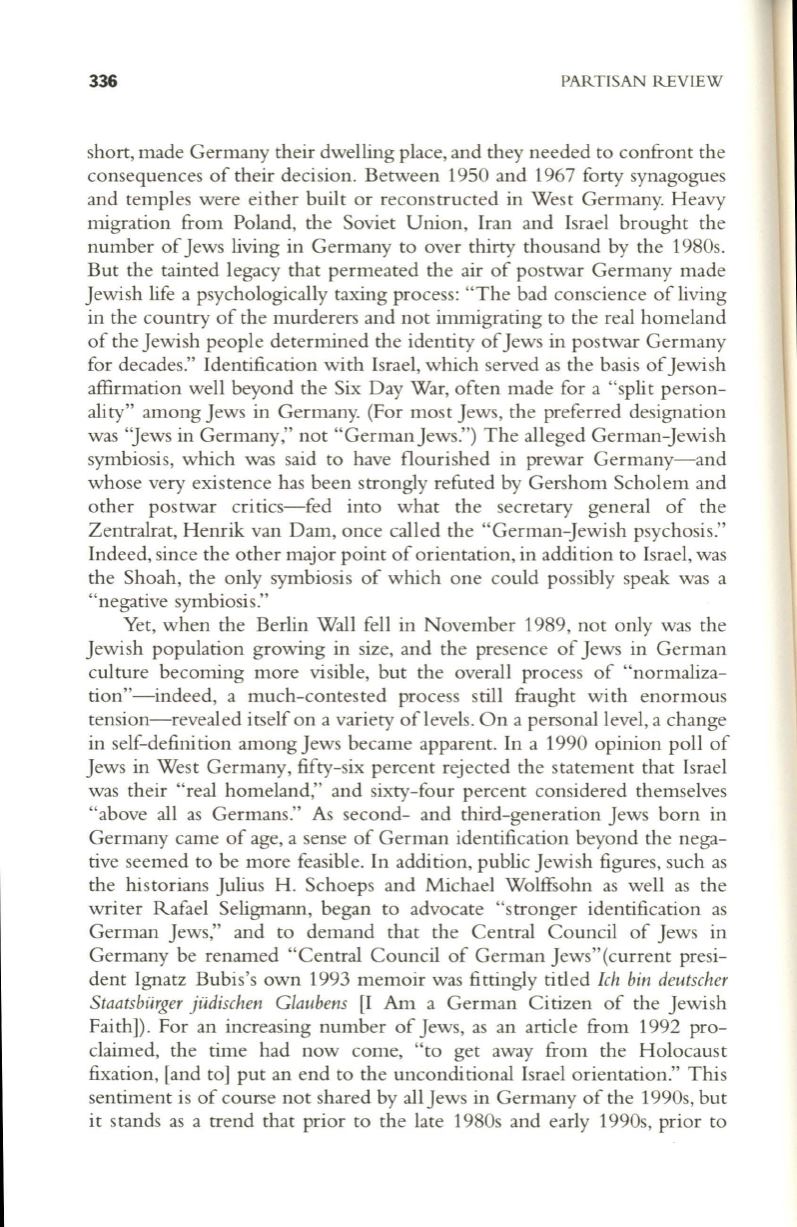
336
PARTISAN REVIEW
short, made Germany their dwelling place, and they needed to confront the
consequences of their decision. Between 1950 and 1967 forty synagogues
and temples were either built or reconstructed in West Germany. Heavy
migration from Poland, the Soviet Union, Iran and Israel brought the
number of Jews living in Germany to over thirty thousand by the 1980s.
But the tainted legacy that permeated the air of postwar Germany made
Jewish life a psychologically taxing process: "The bad conscience of living
in the country of the murderers and not immigrating to the real homeland
of the Jewish people determined the identity ofJews in postwar Germany
for decades." Identification with Israel, which served as the basis ofJewish
affirmation well beyond the Six Day War, often made for a "split person–
ality" among Jews in Germany. (For most Jews, the preferred designation
was "Jews in Germany," not "German Jews.") The alleged German-Jewish
symbiosis, which was said to have flourished in prewar Germany-and
whose very existence has been strongly refuted by Gershom Scholem and
other postwar critics-fed into what the secretary general of the
Zentralrat, Henrik van Dam, once called the "German-Jewish psychosis."
Indeed, since the other major point of orientation, in addi tion to Israel, was
the Shoah, the only symbiosis of which one could possibly speak was a
"negative symbiosis."
Yet, when the Berlin Wall fell in November 1989, not only was the
Jewish population growing in size, and the presence of Jews in German
culture becoming more visible, but the overall process of "normaliza–
tion"-indeed, a much-contested process still fraught with enormous
tension-revealed itself on a variety oflevels. On a personal level, a change
in self-definition among Jews became apparent. In a 1990 opinion poll of
Jews in West Germany, fifty-six percent rejected the statement that Israel
was their "real homeland," and sixty-four percent considered themselves
"above all as Germans." As second- and third-generation Jews born in
Germany came of age, a sense of German identification beyond the nega–
tive seemed to be more feasible. In addition, public Jewish figures, such as
the historians Julius H . Schoeps and Michael Wolffsohn as well as the
writer Rafael Seligmann, began to advocate "stronger identification as
German Jews," and to demand that the Central Council of Jews in
Germany be renamed "Central Council of German Jews"(current presi–
dent Ignatz Bubis's own 1993 memoir was fittingly titled
Ich bin deutscher
Staatsburger judischen Glaubens
[I
Am
a German Citizen of the Jewish
Faith]). For an increasing number of Jews, as an article from 1992 pro–
claimed, the time had now come, "to get away from the Holocaust
fixation, [and to] put an end to the unconditional Israel orientation." This
sentiment is of course not shared by all Jews in Germany of the 1990s, but
it stands as a trend that prior to the late 1980s and early 1990s, prior to


